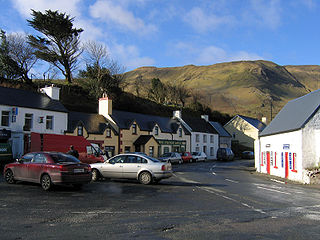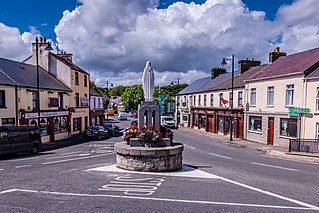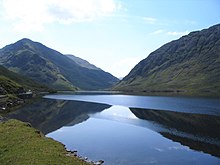
County Mayo is a county in Ireland. In the West of Ireland, in the province of Connacht, it is named after the village of Mayo, now generally known as Mayo Abbey. Mayo County Council is the local authority. The population was 137,231 at the 2022 census. The boundaries of the county, which was formed in 1585, reflect the Mac William Íochtar lordship at that time.

The Great Famine, also known within Ireland as the Great Hunger or simply the Famine and outside Ireland as the Irish Potato Famine, was a period of starvation and disease in Ireland from 1845 to 1852 that constituted a historical social crisis which subsequently had a major impact on Irish society and history as a whole. With the most severely affected areas in the west and south of Ireland, where the Irish language was dominant, the period was contemporaneously known in Irish as an Drochshaol, literally translated as "the bad life". The worst year of the period was 1847, which became known as "Black '47". During the Great Hunger, roughly 1 million people died and more than 1 million fled the country, causing the country's population to fall by 20–25% between 1841 and 1871. Between 1845 and 1855, at least 2.1 million people left Ireland, primarily on packet ships but also on steamboats and barques—one of the greatest exoduses from a single island in history.

Killary Harbour or Killary Fjord is a fjord or fjard on the west coast of Ireland, in northern Connemara. To its north is County Mayo and the mountains of Mweelrea and Ben Gorm; to its south is County Galway and the Maumturk Mountains.

Louisburgh is a small town on the southwest corner of Clew Bay in County Mayo, Ireland. It is home to Sancta Maria College and the Gráinne O'Malley Interpretive Centre.

Leenaun, also Leenane, is a village and 1,845 acre townland in County Galway, Ireland, on the southern shore of Killary Harbour and the northern edge of Connemara.

Murrisk is a village in County Mayo, Ireland, on the south side of Clew Bay, about 8 km west of Westport and 4 km east of Lecanvey.

Crossmolina is a town in the Barony of Tyrawley in County Mayo, Ireland, as well as the name of the parish in which Crossmolina is situated. The town sits on the River Deel near the northern shore of Lough Conn. Crossmolina is about 9 km (5.6 mi) west of Ballina on the N59 road. Surrounding the town, there are a number of agriculturally important townlands, including Enaghbeg, Rathmore, and Tooreen.

Erris is a barony in northwestern County Mayo in Ireland consisting of over 230,452 acres (932.61 km2), much of which is mountainous blanket bog. It has extensive sea coasts along its west and north boundaries. The main towns are Belmullet and Bangor Erris. The name Erris derives from the Irish 'Iar Ros' meaning 'western promontory'. The full name is the Iorrais Domnann, after the Fir Bolg tribe, the Fir Domnann. To its north is the wild Atlantic Ocean and the bays of Broadhaven and Sruth Fada Conn and to its west is Blacksod Bay. Its main promontories are the Doohoma Peninsula, Mullet Peninsula, Erris Head, the Dún Chiortáin and Dún Chaocháin peninsulas and Benwee Head.
Events from the year 1849 in Ireland.
Donncha Ó Dúlaing was an Irish broadcaster who was known country-wide and among the Irish around the world for his cultural and traditional music programmes.
Sancta Maria College is a Catholic secondary school located in Louisburgh, County Mayo, Ireland. The school was Ireland's first Catholic co-educational secondary school.

Doohoma or Doohooma is a townland, peninsula and a census town in the County Mayo Gaeltacht, Ireland. It is located on Ireland's Atlantic coastline overlooking Achill Island and the Mullet Peninsula.
Afri is a Dublin-based NGO that promotes human rights, peace, justice and environmentalism, especially in the Global South, with a focus on injustice caused by conflict. Its patron is Archbishop Desmond Tutu. Another patron of is former UN Assistant Secretary General Denis Halliday.
Doolough is a coastal townland covering an area of 2,493 acres (10.09 km2) in Kiltane Parish, Erris, North County Mayo, in Ireland. It is southeast of Belmullet town and is part of the Mayo Gaeltacht.
The National Famine Commemoration Day is an annual observance in Ireland commemorating the Great Famine. A week-long programme of events leads up to the day, usually a Sunday in May. It has been organised officially by the government of Ireland since May 6th 2008. The main event is held in a different place each year, rotating among the four provinces of Ireland. There is also an international event, held in a place important for the Irish diaspora.

Doo Lough is a freshwater lake in the west of Ireland. It is located in southwest County Mayo on the Murrisk peninsula.

Dugort, sometimes spelled Doogort, is a historical village on Achill Island in County Mayo, Ireland. It is next to Slievemore mountain. There are two blue flag beaches in Dugort: Silver Strand which is located at the foot of the Slievemore Mountain and the Golden Strand which is located further east.
The following is a timeline of the COVID-19 pandemic in the Republic of Ireland in 2021.

The Murrisk Millennium Peace Park is a five-acre park located north of the R335 road overlooking the Atlantic Ocean in the village of Murrisk, County Mayo, Ireland at the foot of Croagh Patrick mountain. The landscaping of the park was purposefully designed to be as unobtrusive as possible, allowing for clear views of Croagh Patrick, the National Famine Memorial, Murrisk Abbey and Clew Bay. The minimal landscaping also serves to reinforce the stark visual impact of Ireland's National Famine Memorial, the "Coffin Ship", a sculpture which stands prominently in the park. The unveiling of the National Famine Memorial by President Mary Robinson on 20 July 1997 predated the opening of the Millennium Peace Park by some four years.













